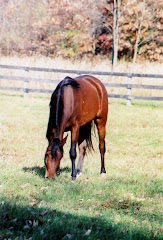
It may surprise you to know that the early equine species originated in North America and remained on our soil, roaming what are now the Great Plains, for about 57 million years. That's a hard number to wrap your head around, I know, especially when you consider the fact that horses are not considered "native" to America. Well, there is a gray area of truth to that, because for unknown reasons, the equus ~ ancestor of the horse as we know it today ~ became extinct on our land about 10,000 years ago, most likely due to changes in the environment, over killing by humans who hunted them for food, and disease. Fortunately, before that happened, many had moved along to other continents where they continued to evolve in Asia, Europe and
By the time the Spanish Conquistadors began their exploration in
After the Spanish introduced the horses to Native Americans, some of the horses became free and gathered in bands, or herds, throughout the western U.S., maybe drawn back to the Great Plains by the call of their fore bearers. Generation after generation they prospered, prey only to mountain lions and wolves, and sought by Indians who had learned to appreciate how these swift horses could benefit the quality of their lives. It is because they originated from captive horses that the mustangs in
For hundreds of years the mustangs lived in the hills and mountains, on the plains, and in the deserts of our country. By the late 1800’s there were about 2 million roaming free in the American west. Having adapted to the harsh and rugged environment, they developed shorter cannon bones, a thicker hoof wall and tougher constitution. They developed their own societies, and co-existed with their own understanding of the hierarchy among themselves.
As the pioneers moved west with their larger European bred horses, mustang blood was used to beef up their strength, agility and intelligence. As the west continued to develop and cattle ranchers claimed the land, mustangs were forced out of their homes to make room for the more profitable cattle. The fewer places there were for the mustangs to live, the more urgent the need to manage their numbers. Which is why we are at this impasse today, why someone needs to decide how to protect them so commerce and industry don't push them into the slaughter houses in Mexico, where they will be butchered and end up on someones dinner plate in Japan.
I am reminded of a short essay I read from time to time called Everything I Ever Needed to Know I Learned in Kindergarten, which is where we all learned how to share. There are days when I would like to send a copy of that essay to all the members of Congress who are assigned the task of deciding the fate of the mustangs, who are as much a part of our history as Christopher Columbus, Thomas Jefferson and Abraham Lincoln..


+of+DallasGrazing.jpg)


